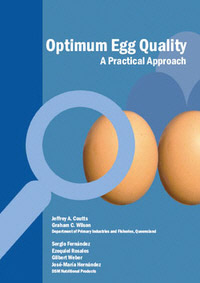
Optimum Egg Quality: A Practical Approach
A fresh egg, with a clean, smooth, brown or white shell, a pure, deep-yellow yolk and a translucent, firm white � this is the ideal of the egg producer and the consumer. How can producers make sure that hens lay more eggs like this, and fewer with shell or internal defects?
The Optimum Egg Quality Handbook describes 15 shell defects and 9 internal defects, each illustrated with a colour photograph. It explains the possible causes and corresponding control measures for each defect.
Introduction
- Preface
- Formation of the egg
- Optimum vitamin nutrition of laying hens
- The nutritive value of the egg
- Internal and external egg quality
- The importance of calcium and vitamin D3
- Quality control
- Changes in quality as the egg ages
- Egg quality in the retail store and in the home
- Consumer perceptions of egg quality
- Egg defects
- Nutrient check list
- Glossary
Shell Defects
COPYRIGHT NOTICE: OPTIMUM EGG QUALITY - A PRACTICAL APPROACH
� The State of Queensland, Australia (through its Department of Primary Industries and Fisheries) and DSM Nutritional Products Ltd., 2007. No part of this publication may be reproduced, copied or transmitted save with prior written permission of Director, Intellectual Property Commercialisation Unit, Department of Primary Industries and Fisheries, GPO Box 46 Brisbane, Queensland, Australia 4001, and DSM Nutritional Products Ltd.
� The State of Queensland, Australia (through its Department of Primary Industries and Fisheries) and DSM Nutritional Products Ltd., 2007. No part of this publication may be reproduced, copied or transmitted save with prior written permission of Director, Intellectual Property Commercialisation Unit, Department of Primary Industries and Fisheries, GPO Box 46 Brisbane, Queensland, Australia 4001, and DSM Nutritional Products Ltd.







